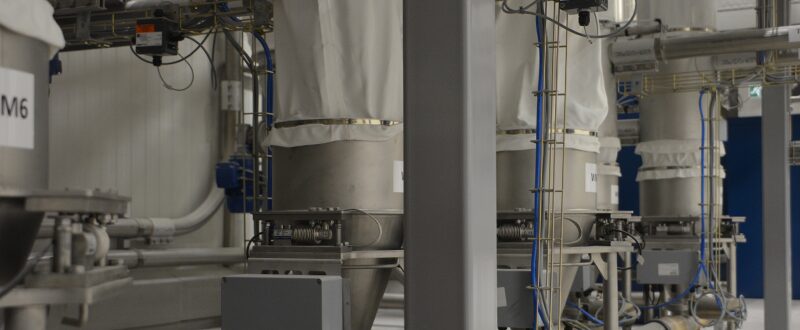
Creating the most efficient baguette bakery
One of the most efficient baguette bakeries in the world is in Mouscron, Belgium. This recent €35 million investment by bakery group Diversi Foods achieves a remarkable overall equipment effectiveness rate of more than 90% thanks to a smart plant and process design with state-of-the-art equipment.
There may be a touch of irony in the fact that this new reference baguette factory is not located in France but in Belgium, although it is just over the border from the French metropolitan area of Lille. Yet the plant is aptly called Boulangerie de France, since Diversi Foods is eager to honor the qualities of the renowned long, narrow loaf, a potent symbol of French tradition and culture. To be more precise, the new bakery produces frozen bake-off baguettes and piccolos of various sizes and types, with or without bran or seeds. Approximately 54,000 tons of loaves are produced each year on two production lines, each with an hourly dough-processing capacity of 3.5 tons. At any one time, between 15 and 18 tons of dough is being processed at Mouscron.
“Pulling the loaf through the factory”
Operational effectiveness has been the number-one priority when developing the plant. COO Alain Daniels, clearly a no-nonsense man, recalls how the project started: “I presented the plan for this super-efficient factory to the private equity firm, quickly received approval, was granted a budget and then I was given almost carte blanche to develop it in a turnkey fashion.”
“This gave me the opportunity to optimize every aspect. I researched the most appropriate location, designed and built the most suitable and efficient building and purchased and installed the best bakery equipment available. Throughout the project my prime consideration has been: what can I do to more efficiently ‘pull the loaf through the factory’, so to speak.
Seizing every opportunity
State-of-the-art equipment plays a major role in this (‘see also ‘A great job of system interfacing’), but it’s more than that. Alain Daniels: “There are plenty of opportunities to increase productivity. For example: there are 168 hours in a week, and we use no less than 152 of them in a truly productive manner, the rest is for cleaning and maintenance. Another example: how many people do you need in a shift to keep such a factory going? We do it with just six, thanks to our smart process design.”
“How much energy do we consume for each ton produced? Benchmarks show that we are at least twice as energy-efficient as comparable factories, mainly because of systematic energy recovery.” “How much waste do we have to discharge? Almost none! What’s more: we are making money from our waste streams as well as from our plastic and paper waste. All these efforts contribute to our 90 to 92% overall equipment effectiveness.”
Proud to show visitors around
No wonder Daniels is proud to show visitors around his site, always seizing on the opportunity to point out the efficiency gains he has made, large and small.
“Look at the production unit interior: it’s simple and neat, with
every corner easily accessible for cleaning and maintenance. Look at the
dual-feed flour dosing system. This redundancy ensures that our dough
production is a continuous process without even the slightest
interruption. And take a look at the hood above the loaf cooling area.
It captures the hot air and transports it to the proofers to help keep
them at the right temperature.” Details, they matter a lot.
Benchmarks show that we are at least twice as energy-efficient as comparable factories
Alain Daniels

A great job of system interfacing
Alain Daniels wanted Boulangerie de France to be equipped with the
best possible baking installations . But what were the criteria he used
to select suppliers?
“First of all, they should be creditworthy and
have the financial and organizational capacity needed to bring such a
project to fruition.”
“Secondly, common sense should be prevalent.
Innovation is important, but suppliers shouldn’t try to reinvent the
wheel all the time. I like it when they work with standard components
where they can. This makes for greater reliability and maintainability.”
“The third point, and probably the most important, is the way they
manage projects, their cooperative spirit and professional attitude.
Because it’s one thing to sell something, and it’s another to make it
deliver on its promise.”
Spiromatic taking the lead
Isn’t that obvious? “Not at all,” elaborates Daniels. “I’ve come
across firms who send just their salespeople to project kick-off
meetings. That’s highly unprofessional and a waste of time.”
“Think about the complexity of our production line, which is made up of four different systems.”
“On
the input side we have ingredient storage, the supply and dosing system
plus a liquids supply line. Further downstream there is the kneading
machinery which delivers to the proofing and baking line, with its
cooling, freezing and packaging areas.”
“These different systems
need to communicate seamlessly with one another as well as with our ERP
system. So, there’s a lot of interfacing work to be done. I highly
appreciated the approach of Spiromatic, who not only supplied the
ingredient storage and dosing system but also took the lead in the
interfacing work. They’ve done a great job.”
I highly appreciated Spiromatic taking the lead in the interfacing work
Alain Daniels

Specifications
Spiromatic installed the following systems and components at Boulangerie de France:
- Eight 35 tons ATEX compliant outdoor flour silos fully equipped with load cells
- Two fully automated dosing lines with mixer robot interface
- Eight 2 m³ buffer hoppers for minor ingredients and seeds
- Eight minor ingredient micro-weighing hoppers
- Tandem grain and seed soaking system
- Siemens TP 1500 Recipe control and ingredient dosing system allowing the correct dosing of water, flour and other ingredients to ensure continuous production
- SPEC production planning, monitoring and visualization software
- Interfacing, including a seamless connector with the ERP system

